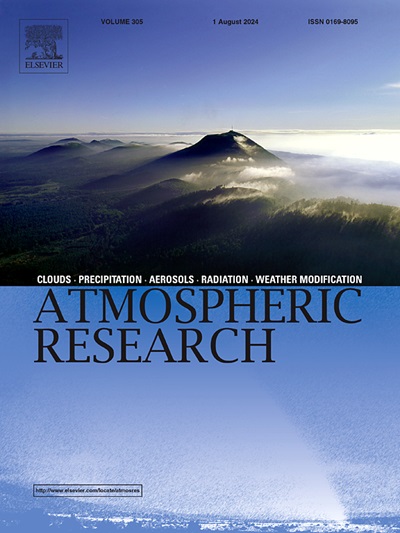Towards an understanding of uncertainties in the Lagrangian analysis of moisture sources for tropical cyclone precipitation through a study case
IF 4.5
2区 地球科学
Q1 METEOROLOGY & ATMOSPHERIC SCIENCES
引用次数: 0
Abstract
Despite the increasing number of atmospheric moisture tracking tools, their validation is challenging due to the lack of observations. This work contributes to a better understanding of uncertainties in the moisture sources analysis for the precipitation of tropical cyclones (TCs) by assessing eight combinations of threshold values in tracking methods based on the Lagrangian water budget equation. We selected as a study case Hurricane Ida that formed in the North Atlantic basin in late August 2021 and extracted the air parcel trajectories from the global outputs of the Lagrangian FLEXPART model. Results indicate that the choice of relative humidity (RH) threshold for filtering precipitating parcels has a noticeable impact on the Lagrangian precipitation estimates. In addition, methods applying the atmospheric boundary layer restriction produce a weaker moisture source pattern than those accounting for moisture uptakes in the whole atmospheric column. In particular, methods imposing an RH restriction along the air parcel trajectories to filter out noise in moisture losses outperform the others, providing more reliable moisture source contributions. We also introduced a simple bias correction approach that further improves the reliability of moisture source representation.
通过研究案例了解热带气旋降水水汽源拉格朗日分析的不确定性
尽管大气水汽跟踪工具的数量在不断增加,但由于缺乏观测资料,对这些工具的验证仍具有挑战性。这项工作通过评估基于拉格朗日水预算方程的跟踪方法中的八个阈值组合,有助于更好地理解热带气旋降水的水汽源分析中的不确定性。我们选择了 2021 年 8 月底在北大西洋海盆形成的飓风艾达作为研究案例,并从拉格朗日 FLEXPART 模式的全球输出中提取了空气包裹轨迹。结果表明,过滤降水包裹的相对湿度(RH)阈值的选择对拉格朗日降水量估计值有明显影响。此外,应用大气边界层限制的方法产生的水汽源模式要弱于考虑整个大气柱水汽吸收的方法。特别是,沿空气包裹轨迹施加相对湿度限制以过滤水汽损失噪声的方法优于其他方法,提供了更可靠的水汽源贡献。我们还引入了一种简单的偏差校正方法,进一步提高了水汽源表示的可靠性。
本文章由计算机程序翻译,如有差异,请以英文原文为准。
求助全文
约1分钟内获得全文
求助全文
来源期刊

Atmospheric Research
地学-气象与大气科学
CiteScore
9.40
自引率
10.90%
发文量
460
审稿时长
47 days
期刊介绍:
The journal publishes scientific papers (research papers, review articles, letters and notes) dealing with the part of the atmosphere where meteorological events occur. Attention is given to all processes extending from the earth surface to the tropopause, but special emphasis continues to be devoted to the physics of clouds, mesoscale meteorology and air pollution, i.e. atmospheric aerosols; microphysical processes; cloud dynamics and thermodynamics; numerical simulation, climatology, climate change and weather modification.
 求助内容:
求助内容: 应助结果提醒方式:
应助结果提醒方式:


